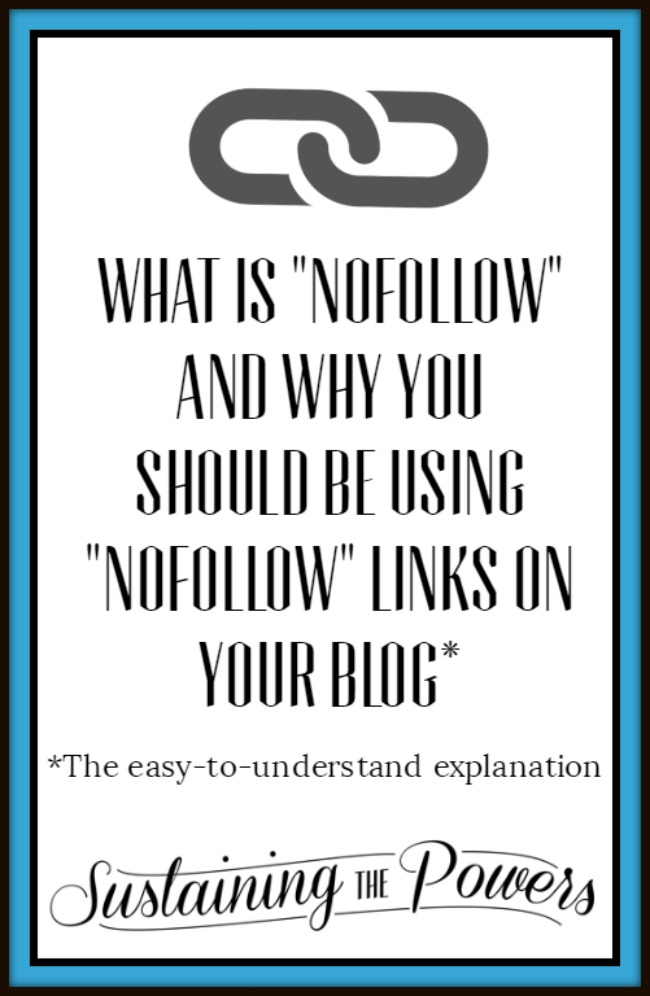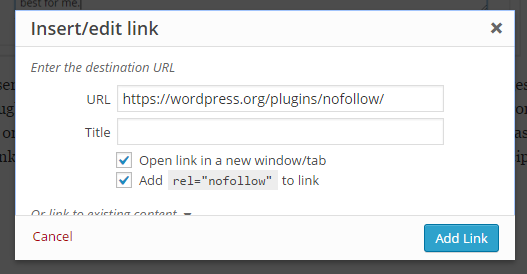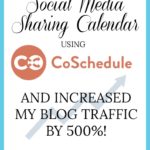Everything a blogger needs to know about using nofollow links with an easy-to-understand explanation.

Are you using nofollow links? You’ve probably heard the word “nofollow” before, but you may not know what it is, or why it is super important to use them.
How important you ask? Well, not using them could result in Google removing your blog from their search results.
Do I have your attention yet? Since most posts about this use lots of techie words, I’m going to try to keep this as easy to understand as possible. Read on to find out everything you need to know about nofollow links.
What are nofollow links?
If you’ve been blogging for a while, you’ve probably heard about nofollow links, but you may not know what they are. In short, it’s a bit of code added to a link that has to do with how search engines allocate Page Rank. Adding the “nofollow” attribute to your outside links (links to sites other than on your blog) tells Google not to pass on your Page Rank to that website.
What is Page Rank then?
Page Rank is similar to a “like” of something on Facebook or writing a positive review of a restaurant on yelp. When one website links to another website, search engines consider it a “vote” for the content on that page. Some of these link “votes” have more weight than others (like when a big blog links to a small blog’s content.) The more links to the page/post, the higher the post will rank in the search results on Google. Hence the term “Page Rank”. (Source) (Page Rank is made of up more than just these link “votes”, but you get the general idea.)
When would I want to use nofollow links?
Untrusted Links -You would definitely want to use the “nofollow” attribute for any site you don’t “trust”, like, or endorse, because you don’t want to “vote” for it on the web.
An example of a common untrusted link on your website would be links in the comments section. Since whoever comments is the one adding the link, you have no control over what the are linking to and therefore don’t “trust” them. Adding “nofollow” to these links can discourage spammers from targeting your site, and “will help keep your site from inadvertently passing PageRank to bad neighborhoods on the web. In particular, comment spammers may decide not to target a specific content management system or blog service if they can see that untrusted links in that service are nofollowed.” (Source)
Paid Links – Google values organic page rankings on their search engine. They really dislike it when money is exchanged for links because they don’t want paid links unfairly influencing search results. According to Google’s Webmaster Quality Guidelines, “Any links intended to manipulate PageRank or a site’s ranking in Google search results may be considered part of a link scheme and a violation of Google’s Webmaster Guidelines.” This could result in your website being dropped in page rank or even removed from Google altogether.
Think about it like this: You’re back in college, and you and a classmate are competing to win a student body election. You have a great, well thought out platform and spend months campaigning and earning people’s votes. Your classmate spends all their time partying, but they have a wealthy family and decide to pay people to vote for them. They win the election because they bought more votes than you could earn. Totally unfair right? They cheated. Google thinks so too, so they don’t allow people to pay for links that build page rank and actively screen for them across the web.
What’s a Link Scheme?
Google has a great post about what they consider to be link schemes and links that violate their webmaster guidelines. A few examples they list that bloggers should be very aware of are:
- Buying or selling links that pass Page Rank. This includes exchanging money for links, or posts that contain links; exchanging goods or services for links; or sending someone a “free” product in exchange for them writing about it and including a link (What we in the blogging world like to call “sponsored posts”.)
- Excessive link exchanges (“Link to me and I’ll link to you”) or partner pages exclusively for the sake of cross-linking. (Do you have a page of link party buttons, blogroll, or button swaps? You may want to add “nofollow” to each of them.)
- Large-scale article marketing or guest posting campaigns with keyword-rich anchor text links (Guest posts are best done with nofollow.)
So how do I use nofollow?
You have a couple options when using “nofollow.” A plugin, or adding a bit of code to your links.
The easiest option for WordPress is to use a WordPress plugin. I use Ultimate Nofollow and I love it because I can have it automatically make all links in the comments “nofollow” from the plugin settings (which has really, really reduced my spam) and then I get this handy dandy check box to quickly add “nofollow” to any links I insert when writing a post:

The other way to use nofollow is to add a little piece of code to any html link you want to nofollow. It would look like this:

So all you have to do is find the link and add the text: rel=”nofollow” just after the URL and before the >. That’s not too hard is it?
What about Blogger you ask?
It’s the same for Blogger blogs as well. (The rules are definitely the same as far as Google is concerned.) You should have a checkbox option for “add rel=”nofollow”” when you go to add a link on your blogger blog (especially because Google owns Blogger!). Here’s a tutorial from Google on adding nofollow to Blogger links if you need help.
What do I do if I have a ton of old sponsored posts without nofollow?
If Google hasn’t flagged it yet, you don’t need to freak out, but make some time in the next month to install the Ultimate Nofollow plugin and go back through any old posts that have a lot of sponsored links and add “nofollow” to each of them. (Often officially sponsored campaigns will give you the link code that already has nofollow included, but it’s always good to check.)
I’d also do that for:
- Any guest posts
- Sidebar button swaps
- Link party posts (inlinkz adds the nofollow for you, but links to other hosts or featured posts may not be nofollow)
- Link party pages
- Blogroll links (this can be automatically done through the ultimate nofollow plugin as well)
Do I need to add nofollow to all my links?
Nope! You definitely don’t need to add it to every single link you post, just the ones that fall into the categories above that Google considers “unnatural” links: ie things like untrusted links, paid links, guest post links, link swaps, and blogroll links.
For example: If you’re writing a post, and want to say how inspired you were by my Mini Frittatas earlier this week with a link, you won’t need to nofollow that link because it occurs “naturally” in an editorial context. I didn’t pay you for it, you just liked them and wanted to tell people about them. (Feel free to link to them, this post, or any of my recipes!)
You also don’t need to nofollow links to content on your own site. You want Google to have a good index of what’s on your own site, so don’t nofollow links to posts on your own blog. That nofollow tells them not to add to the page rank of that post and you definitely want it to move up in the search ranks!
What about sidebar ads from a network like Blog Her or Passionfruit?
Trustworthy ad networks include the rel=nofollow tags in all the links for you, so you shouldn’t have to worry about them. Most networks have an FAQ or a help desk that can answer any questions you have about their use of nofollow.
How about popular tools like Inlinkz or CommentLuv?
Both Inlinkz and CommentLuv add nofollow to any links you add through their services. And again, most popular blogging tools do this, but it’s always good to check if you don’t know.
What other questions do you have about nofollow? Leave them in the comments below and I’ll answer them as best I can.




Wow! I UNDERSTAND NOW!!! Thank you so much for writing this in real human food blogger language rather than techie stuff I don’t understand!!! WHOOT WHOOT! I’ll be coming back for more later – but right now, I have a plug in I need to install! Thank you so much! ~Wendi
I’m so glad I could help you understand! Hopefully I can continue with the “real human” tech tutorials as you put it. Feel free to keep asking questions and I’ll see what else I can help make more accessible for the non-techies. 🙂
This is such a thorough article; I’ve read a few ‘no-follow link’ tips, but it all makes so much more sense now having read your post! Thank you. 🙂
Thank you Kathryn! I was trying to strike a good balance between thorough and overwhelming. There’s so much to learn and so many pieces you have to pull together to be able to understand it all. I’m so glad I could help you make sense of nofollow. 🙂
I am so glad I learned about nofollow links a few months ago! I use this same plugin, and I went back and fixed all my old posts. It has made a big difference in how my posts show up in search results!
I’ve seen a huge difference too! I just went back and looked at my search engine traffic from before and after installing the plugin. Before, I was getting about 1% of my traffic from search engines. 4 months after installing, I’m now getting 12% from search engines. Wow!
Wow, there is so much to learn with blogging. I took two years off and it feels like a whole new world! Thanks for making that so clear. Good to know early on. I’m off to get that plugin!
Blogging is one of those things where I think you could learn and learn and learn for ever. There’s always something new and exciting to try or innovate, or a new plugin to add, or a skill to try to master. I think that’s why I love it so much! I’m glad I could help and enjoy the plugin!
Thank you so much for explaining this is “regular people” language. Since I started blogging I feel like I’ve been learning a new language. This is something I have never even heard of before. Glad to know now. Thanks!
You’re welcome Laura! Glad I could “translate”. Bloggers have to be such amazingly multitalented people. When I explained to my husband all the different software and activities I do to be able to blog he was really shocked. I think your blog name actually captures it all perfectly: Creative Supergirl. (I love it!) I hope you try this and see your search rankings go up!
Thank you so much for explaining it so I finally understand what nofollow means! I’ve been hearing the term here and there and I knew it was important, I just didn’t know why. So, I really appreciate this post!
You are so welcome Tarynn! It’s one of those things that a lot of people say is important, but they never seem to tell you why or how to implement it. I finally had to go digging through Google’s Webmaster Tools archives to get a straight answer, so I thought it was worth sharing. 🙂
Wow, I learned so much! I will be installing this plugin today. Thanks for such an informative article.
You’re welcome Tiffiny! I hope it helps you!
I have been blogging less than a year. I haven’t done any sponsored posts yet. I use comment luv. I don’t think I ever linked to any untrusted comment and I don’t store people’s buttons on my page other than blogher. Trying to think if there is anything I need to use nofollow on yet. Can’t think of anything. … except what about if I link to a product I like when I am not getting paid. I have done that a few times when talking about canning products I Like. What about that?
I think you may be good then! I do typically use nofollow when linking to products on large company’s pages, just because I don’t want to give places like Amazon a free search engine boost, but it’s not necessary. And if I really like the company (especially small businesses), I don’t use nofollow because I want them to do well! Does that answer your questions?
I learned something new today! Yay!! I will have to go an see how this affects bloodspot blogs. Thanks so very much for being such a smart gal!!-Sue
It’s the same for blogspot blogs as well. (The rules are definitely the same as far as Google is concerned.) You should have a checkbox option for “add rel=”nofollow”” when you go to add a link on your blogger blog (especially because Google owns Blogger!). Here’s a post about it if you need help.
Hey Stephanie! I saw you post this link in the Peony Project recently and I’m so glad I saw it! It explained no follow so much better than anywhere else I had been reading about it and I just downloaded that plugin! Quick question, should I be using no follow on affiliate links as well? Like when I link to an item on Amazon and it’s an affiliate link? Thanks so much!
Sorry Liz, I just saw this comment! Yes, I would use nofollow on affiliate links as well. I tend to be a bit “nofollow” link happy though. My general rule of thumb is to use it on any link where money or value might have or will be exchanged (including links to companies or products on the web) or where linking back was required for participation (like link parties, link ups, etc). Anything organic that wasn’t solicited I leave as “dofollow” aka regular links. (ie I LOVE this recipe from Stephanie and made it last week which inspired me to do…) Hope that helps and sorry for the delay!
What about blogger blogs?
Great question! I answered this a couple times in the comments below, but I just added it to my post. Blogger already has the add “nofollow” checkbox option built into their link system or you can manually add it using the code snippet in my post above (this method comes in handy for link buttons and html a brand might send you). There’s a link to a tutorial up in the post now. 🙂
Thank you! I guess I passed right by it.. Sorry about that! 🙂
You didn’t! I added it to the post after I read your comment since it was a great question. 🙂
This is a GREAT post Stephanie! I’m bookmarking this for future reference. 🙂
This was so incredibly helpful!! Thank you!! xo
The only place I wouldn’t change them is guest posts. I’ve read varying opinions on these, but to my knowledge, as long as the guest posts are quality, within the same niche, and don’t appear to be a part of a scheme or something inflated, this is one place where no follow isn’t essential.
I would tend to agree with you, though the guidelines I list are quoted from what Google has put out. Depending on how you interpret “guest posting campaigns with keyword-rich anchor text links” I think it could mean both full on campaigns with the same guest post shared on several sites, or just a single guest post series on your blog, so I’d be more inclined to go with better safe than sorry if you’re unsure.